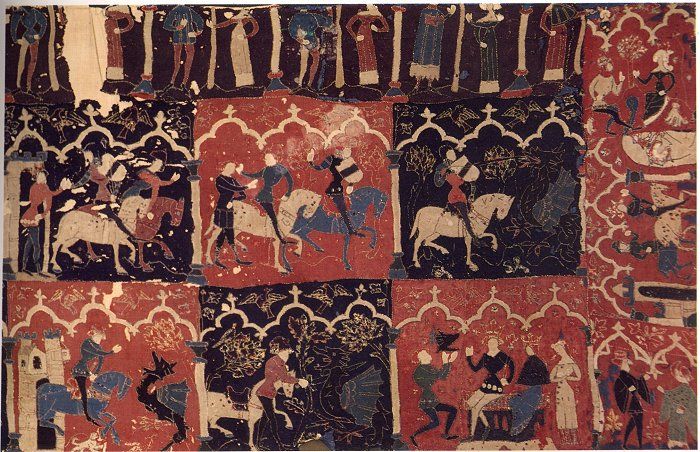Couching and Laid Work

Depending on the type of thread used, couching can be one of the most economical uses of thread, or a high use technique.
Couching works especially well when doing metal thread embroidery. Often the gold and silver cords are too thick to actually stitch to the fabric, so they are laid along the design and then a silk thread in a matching colour to the metal thread is used to secure the cord to the fabric. The picture below is one of the most simple ways to couch down a piece of metal thread. This is known as surface couching.

As you can see, the gold cord is couched down in pairs, and the couching threads are offset so that they do not cause “bumps” in the end design.
The gold perle thread on the outside is also couched down, however the couching thread is slipped between each spiral, so it is not seen.
Underside Couching is a similar method, except the couching thread is pulled tight, causing a small loop of the laid thread to pull through to the underside of the fabric. This can give a quilted appearance and was commonly used in Opus Anglicanum work.

This Chasuble from the middle ages is stitched in gold and silver gilt threads using underside couching.
In surface embroidery, there are a number of forms of self couching. This is where the same thread is used to anchor the couched thread. Roumanian and Bokhara are two very popular forms of this, and are often used in surface embroidery as an effective filling stitch.
Personally, I like to use Roumanian couching for leaves as the stitch gives a nice “vein” down the middle of the motif.

This is Roumanian Couching.
In most forms of couching, the colour of the thread used to couch is the same (or as similar as possible) to that of the thread being couched. Often these are stitched to form a pattern in the couching, that sometimes can only be seen from a particular angle or in the right light.
In the Goldwork form of Or Nue, the thread couching down the gold jap is a different colour, and the design is actually made up from the pattern of the coloured threads.
For further examples, I have done an article on Or Nue - the link to this article is at the bottom of this page under "Related Links"
Laid Work is slightly different to couching, in that the couched thread is then overlaid at right angles with another thread, and the two are couched to the fabric base at their join. This couching can be either so small as to be nearly invisible, or large, and forming part of the decorative stitch.
You can even take it a step further, and if there is a large area of laid work, you can use coloured threads in much the same way as Or Nue and do what amounts to a “design in a design”.
Laid Work can have the laid threads either very close together, or further apart. The Bayeux Tapestry is an example of Laid Work used to fill in a design.

Klosterstitch is similar to Bayeux Work and originates from Germany. The picture below is a German Klosterstitch wall hanging depicting the story of Tristin and Isolde. Klosterstitch and Bayeux work were used to do large wall hangings.

The picture below shows laid work with the threads further apart. This is often called “trellis stitch” and has long been a popular stitch in crewel embroidery, where it is used by itself (as here) or over areas of satin stitch.


The beauty of both couching and laid work is that they can be as simple or as complex as you desire, and the threads used can be as rich as pure gold couched to a fabric such as velvet (as with the Chasuble above) or humble wool on linen (as with the Bayeux Tapestry).
As always, with embroidery, your imagination is the only limit!
Recommended Reading
Goldwork (Essential Stitch Guides)
Mary Thomas's Dictionary of Embroidery Stitches
The Bayeux Tapestry Embroiderers' Story
Links
Surface Couching tutorial on YouTube
Underside Couching tutorial on YouTube
Is there anything that you would particularly like to see an article on? If so, please contact me with your suggestions.
Happy Stitching
© 2014 Megan McConnell
This site needs an editor - click to learn more!
You Should Also Read:
Or Nue Embroidery
Opus Anglicanum Embroidery
Using Metal Thread
Related Articles
Editor's Picks Articles
Top Ten Articles
Previous Features
Site Map
Content copyright © 2023 by Megan McConnell. All rights reserved.
This content was written by Megan McConnell. If you wish to use this content in any manner, you need written permission. Contact
BellaOnline Administration
for details.


